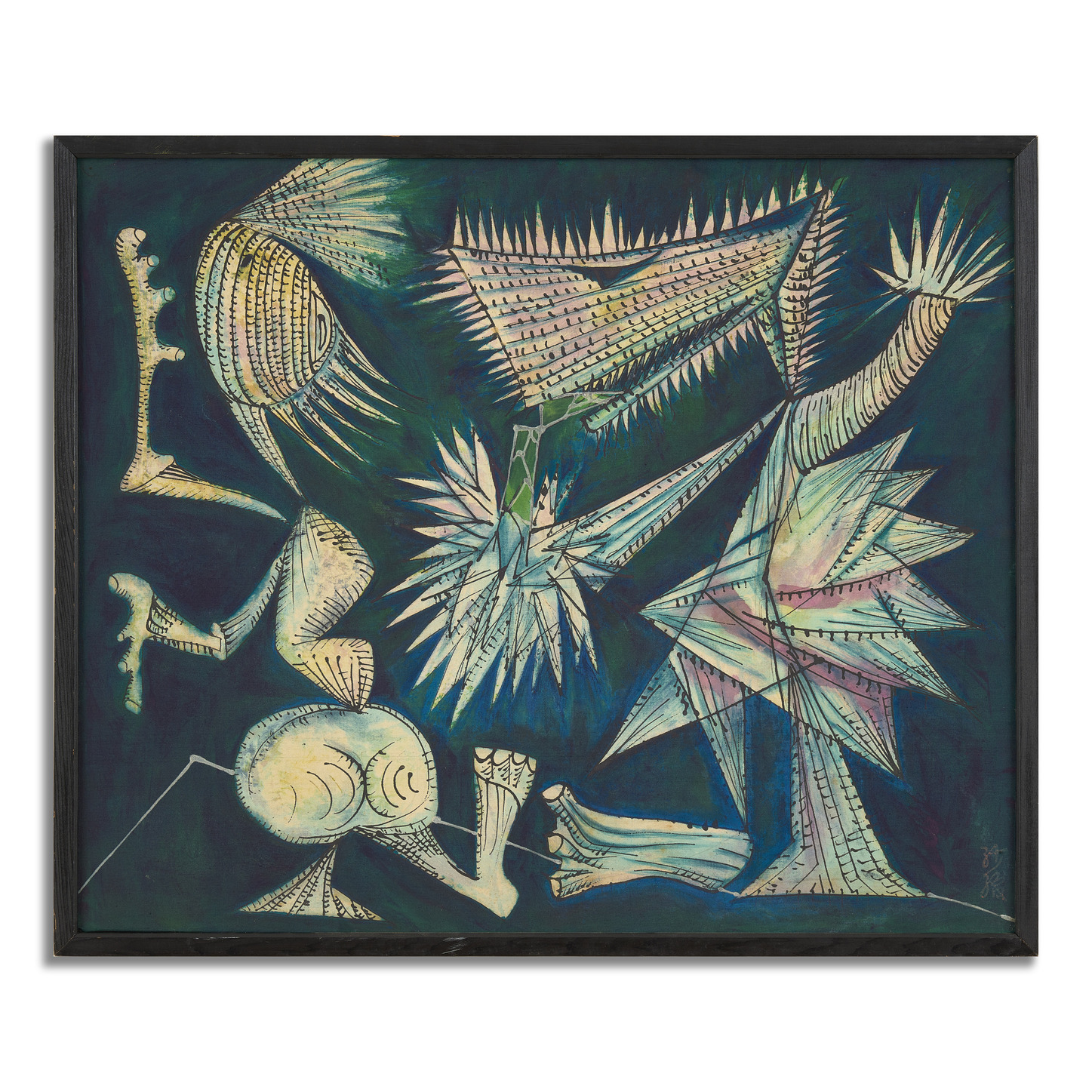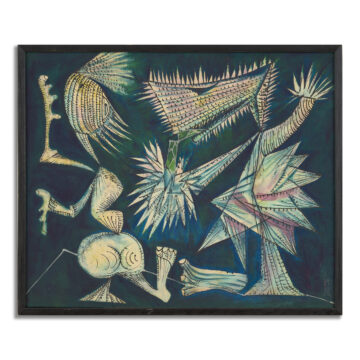
NUKAGA GALLERY will be holding an exhibition entitled "Akutagawa Saori: Fierce. Burning. Intense," from Monday, May 20th to Wednesday, July 3rd, 2024, showcasing the precious works she left behind during her short life.
NUKAGA GALLERY will be holding an exhibition entitled "Akutagawa Saori: Fierce. Burning. Intense." from Monday, May 20th to Wednesday, July 3rd. This exhibition will feature works created by Akutagawa, who gained attention as an avant-garde artist from the early 1950s and passed away suddenly in 1966 at the age of 41, including her representative works and drawings. She continued to burn with energy in pursuit of her own unique expression throughout her short career of around 15 years as an artist.
What's important is not the technique, but the overflowing of the technique. I want to let my individuality writhe on the canvas. There's no need to strive for something perfect. Something fierce. Something burning. Something intense.
(Saori Akutagawa's diary, April 1954)
This year marks the 100th anniversary of her birth, and momentum is building for a reevaluation of Saori Akutagawa. Art museums across Japan are marking this occasion with special exhibitions of her works, and art museums overseas are beginning to acquire her work as one of the leading figures in postwar contemporary art.
Saori Akutagawa was born in Aichi Prefecture in 1924. She enrolled in the vocal music department of the Tokyo Music School (now Tokyo University of the Arts) in 1947 with the aim of becoming a musician. However, while still a student she married her classmate Yasushi Akutagawa (later the composer), and gave up on her dream of becoming a musician after she was asked to give up on the idea of having two musicians in the same household.
However, her desire to express herself was insatiable, so she began to pursue the path of painting, which she had been doing during her time at high school.
What is art? Why do I paint? Sometimes these feelings come over me. But I think that's okay. I'm very happy, so I have a fire in my heart. I feel like I have to keep something burning or I'll turn to cold ashes.
(Saori Akutagawa's diary, November 1953)
In 1955, he was selected by Taro Okamoto to exhibit in the Nikakai Society's Ninth Room, or "Nine Rooms Society," where he won the Special Scholarship Award and quickly became one of the leading up-and-coming artists.
Initially, he painted works with the theme of "women", but he soon began to look for subjects in "folk tales" and "myths", and produced dyed paintings filled with primitive images. This eventually led to his original masterpiece "From the Kojiki" (1957, 176 x 1346 cm, Setagaya Art Museum).
However, the rift between her and Akutagawa Yasushi only grew, and they divorced in 1957. She then traveled to the United States, where she studied at a design school in Los Angeles for a year, before moving to New York and studying abstract painting at the Art Students League of New York.
After returning to Japan in 1962, she began exhibiting abstract paintings, and the following year she married Yukio Madokoro, an architect with whom she had traveled to the United States.
It's neither cold nor hot, and the new green leaves are dazzling. My art studies are progressing well. It's my joy, my ideal life. I've been dreaming of this kind of life for a long, long time. At last, I'm able to draw pencil lines freely.
(Saori Akutagawa Diary, May 15, 1965)
On January 31, 1966, Saori Akutagawa died suddenly at the young age of 41 due to preeclampsia.
This exhibition features a selection of Akutagawa Saori's works, ranging from her early oil paintings to dyed paintings, abstract paintings, and even drawings, allowing visitors to grasp the complete picture of her work.
We hope you will take this opportunity to view the powerful pictorial expression that is integrated with his bold way of life.
* Excerpt from Saori Akutagawa's diary: "Art Life" Vol. 26, No. 9, September 1973
■Event summary: "Saori Akutagawa: Something fierce. Something burning. Something intense."
Dates: Monday, May 20th – Wednesday, July 3rd, 2024
Opening hours: 10:00-18:00 (Monday-Friday) *Closed on Saturdays, Sundays, and holidays
■ Venue
NUKAGA GALLERY
〒104-0061 2-3-2 Ginza, Chuo-ku, Tokyo Eiko Ginza Building 3F
Access: 3 minute walk from JR Yurakucho Station, 1 minute walk from Ginza-itchome Station on the Tokyo Metro Yurakucho Line
■Artist: Saori Akutagawa
Akutagawa (maiden name Yamada) Saori was born in 1924 (Taisho 13) in Takashi Village, Atsumi County, Aichi Prefecture (now Toyohashi City). After graduating from the vocal music department of the Tokyo Music School (now Tokyo University of the Arts), she married composer Akutagawa Yasushi. However, after her marriage, she refrained from singing at home and gave up on vocal music. She instead resumed painting, which she had done in her girls' school days. She attended the research institute of Inokuma Genichiro and studied oil painting and batik under Noguchi Michikata.
In 1953, at the recommendation of Keiko Akaana, he submitted his work to the 17th Shinseisaku Association Exhibition, but was not selected.
In 1954, she exhibited at the 6th Japan Independent Exhibition. She exhibited works such as "Woman" at the 4th Modern Art Association Exhibition and won the Newcomer's Award. She participated in the Seven Women Exhibition with Abe Machi, Oda Lila, Ogushi Satoko, Onosato Tomoko, Kusama Yayoi, and Mori Satoshi. She traveled with her husband to China, the Soviet Union, and Eastern Europe for several months. Her visit to the Soviet Union prompted her to start creating works based on the theme of folk tales.
In 1955, at the recommendation of Taro Okamoto, he moved to the Nikakai with Taizo Yoshinaka and Noriaki Fujisawa. He won a special prize for his dyed works "Woman B" and "Woman XI" at the 40th Nikakai Taro Okamoto Room (Room 9). In September, he was impressed by the Mexican art exhibition. "I had seen Tamayo's paintings in a primary color edition of an art magazine before, and I was deeply attracted by the mysterious colors," he said. He held a solo exhibition at the Muramatsu Gallery, exhibiting "Folktale Kukunochi" and "Izanagi no Mikoto's Nation Building." He exhibited "Ototachibana Hime Drowning" and "Kukunochi Pushing Up the Heavens" at the "Today's New Artists 1955" exhibition at the Museum of Modern Art, Kanagawa Prefecture.
In 1956, he held the first four-person exhibition at Sato Gallery with Ikeda Tatsuo, Kawara On, and Yoshinaka Taizo. Members of the "Contemporary Art Institute" headed by Okamoto Taro (Akutagawa, Nambata Tatsuoki, Fukushima Hideko, Fujisawa Noriaki, Takehata Kakuzo, and Yoshinaka Taizo) designed and sold yukatas at the request of a kimono wholesaler. He exhibited "A Young God Lies in the Great Tree" at the Nika Spring Exhibition. He exhibited "Myths: The Birth of the Gods" at the 41st Nika Exhibition. He held the second four-person exhibition with Ikeda Tatsuo, Kawara On, and Yoshinaka Taizo, and exhibited "From Myths."
In 1957, she held her third solo exhibition at the Muramatsu Gallery, exhibiting "From the Kojiki" [8]. She divorced Yasushi Akutagawa.
In 1958, during the raging Isewan Typhoon, he left for the United States and studied graphic design at the Los Angeles Art Center School. His work was selected for an open exhibition at the Los Angeles County Museum.
Arrived in New York in 1960. Participated in the 14th Japan-US Friendship Exhibition of the Association of Women Artists (Riverside Museum of Art, New York) as an exhibitor in the US with Yuki Katsura, Ryuei Murao, and Yayoi Kusama (under the name Saori Yamada). Studied oil painting at the Will Barnett class of the Art Students League of New York (until 1962).
He returned to Japan in 1962 and held his fourth solo exhibition at Showa Gallery, exhibiting works he had made during his time in the United States.
In 1963, she exhibited "Black Shape B" at the 17th Women Artists Association Exhibition. She married the architect Yukio Madokoro.
In 1965, she exhibited "Sphinx" at the 19th Women Artists Association Exhibition.
She died of pregnancy-related toxemia in 1966.
■Inquiries
NUKAGA GALLERY
EMAIL: info@nukaga.co.jp URL:www.nukaga.co.jp
TEL +81(0)3 5524 5544 / FAX +81(0)3 5524 5543
From the press release of Nukaga Co., Ltd.
<Past related articles>
ATELIER MUJI Special Exhibition "Something that is Both – Mitsuru Koga's Perspective"
